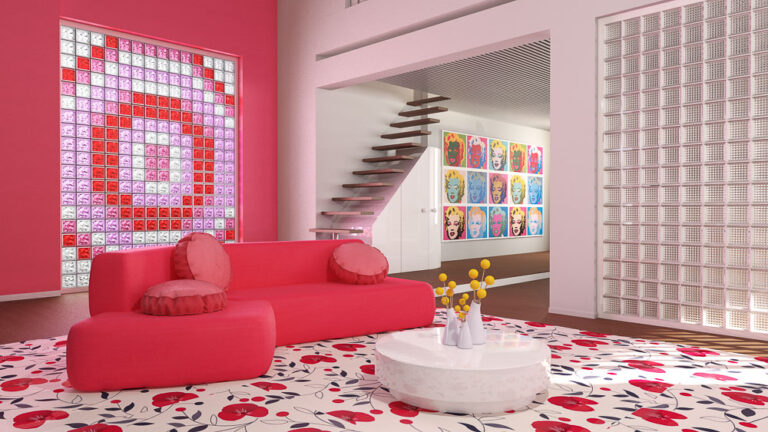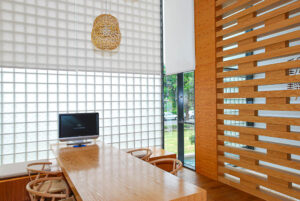Interior Designers are using glass block in a whole new way, creating interiors that are sometimes chic and elegant, sometimes fun and quirky, but always resulting in a room you’d love to spend time in.
Interior design is rooted in solid principles and elements that can guide you as you create your own beautiful home interior using glass block. Interior design employs the elements of space, form, line, light, color, pattern and texture, all together to create a space that feels balanced and harmonious, yet still visually interesting and energizing. Below we look at each interior design element in turn, and suggest how to use glass block to fit within this model.
Glass Block and Space.
Space, in interior design, refers to the physical boundaries of a room. Space can also refer to how you use the space within a room, and this is where your use of glass block could make a difference. Space can be split into positive and negative space, positive being the part that is filled with objects, and negative being the empty space. If a space has too much stuff in it, it will feel uncomfortable and constrained. If it is too empty, it will feel cold and unfriendly. A balance needs to be achieved depending on the type of mood you’d like to create as well as for the function of the room. A modern, minimalist style will incorporate more negative space, while a comfortable family room might contain more positive space.
- Adjust glass block accent pieces, such as a kitchen island or a bar for the size of the room to ensure enough negative space. Consider reducing the size of the glass block base and having a greater countertop overhang, or incorporating wood framing between blocks or around sections if a more delicate island or bar would suit your space better.
- Use glass block partitions between rooms to increase the feeling of space.
Glass Block and Form.
Form refers to the shape of the room as well as of the objects within the room. Glass block is an interesting material, in that it is geometric and hard-edged, yet open, because of its transparency. Attaining a balance of man-made/geometric and natural more flowy forms will create more personality and depth to the feel of a room. To achieve a sense of balance and harmony with form, use objects with a similar shape throughout the room.
- Balance the cool, hard aspect of glass block with coarse, natural materials such as wood, stone, brick or natural fabrics.
- Balance the straight lines of glass block with natural forms such as plants.
Glass Block and Line.
Line refers to the horizontal, vertical and dynamic lines that make up a space. The horizontal lines created by surfaces, or horizontal windows impart a sense of stability and calm; think of the sense of peace you might get from looking at the ocean’s horizon. Vertical lines, such as vertical windows, doors and tall furnishings command attention. They are uplifting, and impart feelings of awe and empowerment. Dynamic, diagonal lines such as a staircase or fabrics with zigzag patterns create a sense of movement and action.
- Use vertical glass block windows to create a sense of height and give a feeling of awe and strength. Be careful with other interior elements though — too many vertical lines can feel confining.
- To create an uplifting feel in a large expanse of a glass block wall, you can split the wall into lengthwise panels, divided by a solid material such as wood.
- Use horizontal glass block windows to expand the width of a room, making it feel more enclosed, protected, intimate and tranquil. Add some vertical or zigzag furnishings or details to add some excitement.
Glass Block and Light.
Light is a critical aspect of interior design, affecting the mood, functionality and even the perceived size of a space. With so many options, this is where glass block windows can really make a difference adding ambient, task and even accent natural lighting to a space.
- Use a clear pattern such as “Clarity” in places you need more direct light transmission
- Use a pattern such as “Opal” for a soft, diffused light, and a high degree of privacy
- Consider the placement of windows for different functions. For example, kitchen glass block backsplashes for task lighting or clerestory windows for a diffused, ambient light.
Glass Block and Color.
Color can truly transform a room. Lighter colors will give the illusion of space while darker colors add depth. Color has a profound impact on mood. For example, blues and greens are calming, while red is energizing. Glass block comes in a wide range of colors that can be used to add excitement and a pop of color to your windows or partitions.
- Practice the ‘rule of three’ when using colors in a room: 60% should be a dominant color (often neutral), 30% a secondary color and 10% an accent color/pattern.
- Color glass block is best used as a secondary or accent color.
- Use pops of secondary and/or accent color in a feature wall or window.
Glass Block and Pattern
Along with color, patterns add character and life to a room. Glass block comes in a variety of patterns and sizes that can be combined to create a decorative window.
- As with using color, follow the rule of three when designing a multiple-patterned window
- Use a combination of patterns in a feature wall/window
- Use single glass block to create a pattern or grid of small windows
- Play with different opacities
Glass Block and Texture.
As already mentioned, even though surface patterns can soften the look of glass block somewhat, glass block is still a cool, smooth material with straight lines. To add contrast and warmth to a room, try combining glass block windows with rough natural materials such as wood, stone, brick and natural fabrics.
Create Your Dream Interior Space with Glass Block!
With these basic design tips for incorporating glass block into your interior design, you are sure to create a space that fits its function as well as the mood you want to create. Have fun with it and let your creativity shine!





Give us a follow!